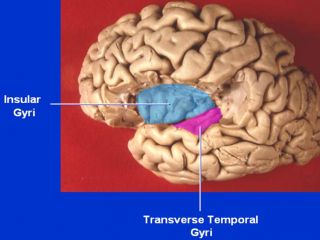Stress
Are Temper Tantrums a Fight/Flight Response?
Could training the insula help our brain deal with threats and discomfort?
Posted December 7, 2012
I recently received an interesting comment that I wanted to respond to in greater depth. Cheryl , a nurse, described a technique that patients with breathing problems (e.g. chronic obstructive pulmonary disorder) used to overcome attacks of rapid, shallow breathing that led to shortness of breath. Anyone who has been submerged in water for longer than they expected knows how frightening shortness of breath is when you feel you can do nothing about it. The fight/flight response quickly activates.
She taught patients a breathing technique, pursed lip breathing, that slows air intake. At the same time, she instructed them to visualize positive memories, such as cooking with grandchildren. The combination of pursed-lip breathing and soothing thoughts quickly helped her patients to slow their breathing, calm down and turn off the stress response.

Cheryl has a 3 year old granddaughter who has temper tantrums, and she wondered if the fight/flight response might be driving the tantrums. If so, could tantrums be short-circuited with the breathing exercise?
The reason this comment interested me is because I've always found the relationship between the mind and body fascinating. For instance, simply recalling an argument with a girlfriend can trigger a flood of angry thoughts and, in less than a second, cause your heart to race, raise your blood pressure and make your gut tense up.
The short response to Cheryl's question is that yes, I do believe tantrums reflect a fight/flight response and yes, the breathing technique could help children calm down. The fun part is thinking about why the breathing/happy thought technique works. To answer this question, it's necessary to explore the brain and body relationship.
When our lives are in danger, we have a built in response to mobilize our defense. The fight/flight response would naturally kick in if, on a hike in the mountains, you stumble upon a bear. The bear is processed in the brain as a potential threat to your survival, so within seconds your brain releases norepinephrine (also called noradrenaline), and within minutes a surge of cortisol will circulate through your body. These chemicals rapidly mobilize your body for energy utilization. You will release sugar into the blood stream for energy, your pupils will dilate to take in more information and your muscles will be ready to contract rapidly.
Temper tantrums are a version of the same response. Conflicts, such as a battle over whether to buy a bag of skittles at the store, may not be life-threatening, but they are fights nonetheless. A tantrum also speeds the heart rate and is accompanied by bursts of norepinephrine and cortisol. As evident by how long an adamant child can carry on, energy must be mobilized so the child can make sure its demands are heard, often by everyone in the store.
Life is full of stress, including not getting our way, and this is how young children deal with it. In my opinion, learning better ways to cope with stress is one of the most important skills a child learns. The pursed-lip breathing/soothing thought training is certainly a way to deal with stress.
The critical element of the technique, I think, is that it disrupts the thought process. Stress is a feedback loop. Anxious thoughts lead to sweaty palms, and the awareness of sweaty palms reminds you how anxious you are, which makes your palms sweat (this idea is similar to the classic James-Lange theory of emotion). To stop the cycle, you must either stop your palms from sweating or curb your anxious thoughts. For someone experiencing shortness of breath, pursed-lip breathing and thinking happy thoughts interrupts the cycle in both places, the mind and body.
One of the mysteries of this process—one that we are beginning to uncover—is how the brain processes this bodily awareness and how that affects our behavior. A critical structure seems to be the insula. This prune shaped region buried an inch beneath the outer surface of the brain is activated as we become aware of our bodies. When consciously thinking of your heartbeat, for example, the insula is hard at work.

One of the tasks our lab uses is designed to tweak the insula. While lying in a MRI scanner, we give participants a nose plug and place a mouthpiece on them so that we can restrict their breathing using a resistor. They are still able to take in oxygen, but it requires much more effort. As breathing, an act that usually takes place beneath conscious awareness, becomes restricted, it comes front and center in your attention. At the same time, insula activation increases, presumably encoding enhanced awareness of your body's condition.
The interesting part is that not everyone becomes equally aware of their body, even when their breathing is restricted. Highly trained endurance athletes, for example, have greater insula activation during breathing restriction than typical people do. This heightened awareness may indicate that their insula helps them anticipate their body's needs and respond to them. That way, during a grueling 10 hour bike ride, they can anticipate pain and deal with it before it cripples them, allowing them to make it to the finish line.
To tie this back to temper tantrums, toddlers' insular cortices may indicate what their bodies need. However, their insula may not have developed enough to anticipate discomfort and deal with it calmly. When they want a toy, they feel that they need it. They lack the insight to distinguish between needs and wants. I have not seen developmental studies showing how insula activity matures over time, but one hypothesis about how temper tantrums relate to the brain and the fight/flight response is that their insula becomes more attuned to their body's condition as they grow older, allowing them to better respond to their body's needs..
Finally, current studies are examining how training the mind affects the insula. We're examining a group of students before and after a mindfulness course to see if it affects activity in the insula. Just as mindfulness training could train the insula, so too could slowed breathing and soothing thoughts train your toddler's insula. A few years from now, we should have a better answer to that question.
If you have any thoughts or ideas related to this post, feel free to share them in the comments below.
image source: mdanys
image source: Wikipedia




